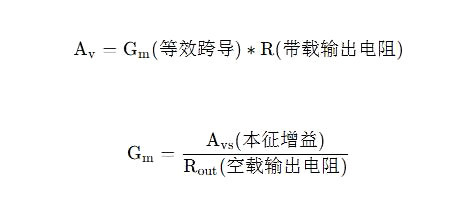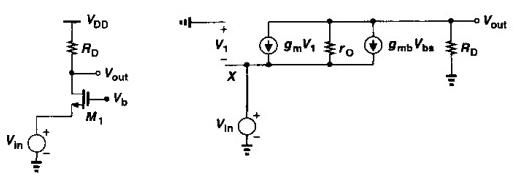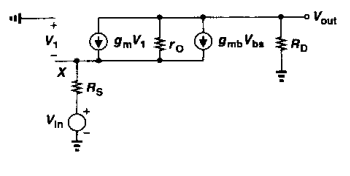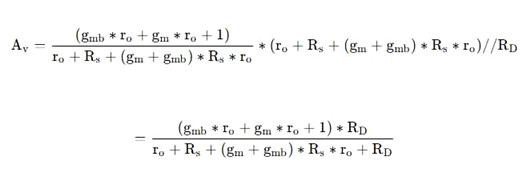Comparison of Small Signal Gain of Common Standard Stage and Common Source Stage MOS Tube Amplifier
Understand the connection and area of the small signal value-added of the two Amplifiers of the common standard level and the common source level, and investigate the intrinsic gain of the common standard level Amplifier, and examine the public standard in a general way.
common method:

Common gate stage with zero input resistance
The reason why the input resistance of the common source stage is not mentioned above is that the input impedance of the common gate stage is generally considered to be ∞ at low frequencies, which is not considered. For the common gate stage, the input signal is directly connected to the circuit, and the input resistance needs to be considered.

The figure on the left is a direct-coupled common gate stage, V b is connected to a fixed potential, and the resistor RD is used as a load. The figure on the right is a small-signal equivalent circuit (the level of drawing is poor), the gate is grounded, and the drain is output. The output resistance of this figure (both voltage-controlled current sources are zero when V i n = 0) is clearly r 0 and the load resistance is R D .
When the above conditions are clearly explained, according to our formula, the only difference is the intrinsic gain of the source input. For the common-source circuit, the intrinsic gain is g m ? r o, and the gate-source voltage of this gain is used as the control voltage to affect the leakage current of the tube. Therefore, if we want to know the intrinsic gain of the common-gate stage, we need to investigate the lining source The effect of voltage (back gate) on the leakage current of MOS transistors.
Understanding of Intrinsic Gain
Similarly, both the gate-source voltage and the back-gate voltage change the leakage current through a voltage-controlled current source, so there will first be a gain g m b − r o induced by the back-gate voltage. The question is, does the existence of the back gate voltage only cause this part of the gain?
Obviously not, we see from the small-signal circuit that due to the existence of the back-gate voltage, the gate-source voltage is also raised to the same potential as the back-gate voltage, so it causes the same amount of the second part of the gain g m ? r o, finally, **Because the input signal is directly connected to the circuit, due to the channel resistance, there is also a gain of 1** for the circuit itself.
So, in summary, the sum of the gain due to the back gate voltage is ( g m b ? r o + g m ? r o + 1 ).
So we can get the result by formula:

Comparing this result with a resistively loaded Amplifier of the common-source stage, it is found that the gain of the common-gate stage input is larger (the intrinsic gain is one or two orders of magnitude larger than 1, and the back-gate transconductance is an order of magnitude smaller than the gate-source transconductance , so the overall difference between the two is not very large).
Common gate stage considering input resistance

In terms of structure, we see that the small signal circuit is very similar to the common source stage, only the input is changed from the gate source terminal to the lining source terminal, and the properties of the circuit itself (no-load and load output resistance) have not changed, no-load The output resistance is [r o + R s + ( g m + g m b ) − R s − r o ] so we draw the conclusion directly from the formula.

After comparing the two Amplifiers, we got some conclusions: they are similar in amplification mode, they both control the output leakage current through the voltage to drive the load to achieve amplification, but the amplification capabilities of the two are different, and the common gate level The leakage current comes from many places, so it has a stronger amplification capability than the common source stage. However, the common-source amplification method is simple, and the change to the circuit is small, which is convenient for analysis and avoids the body effect at the same time.
Contact: Emma Tan
Phone: +8613650089053
E-mail: emma@yfwdiode.com
Add: No.9 Cuibi street,Nancheng,Zhang mutou town,Dongguan City,Guangdong Province